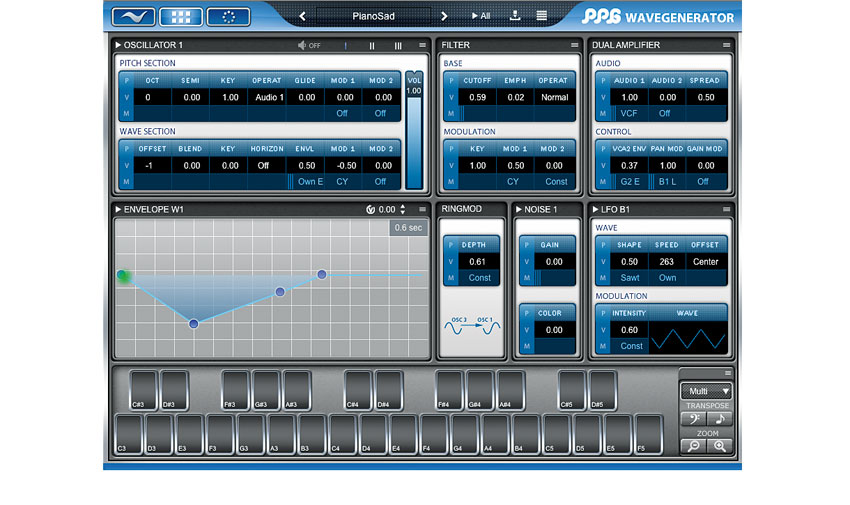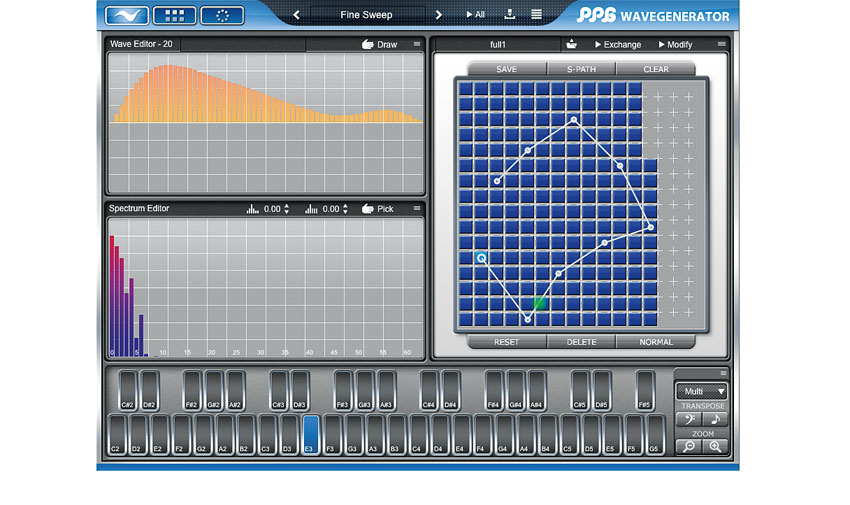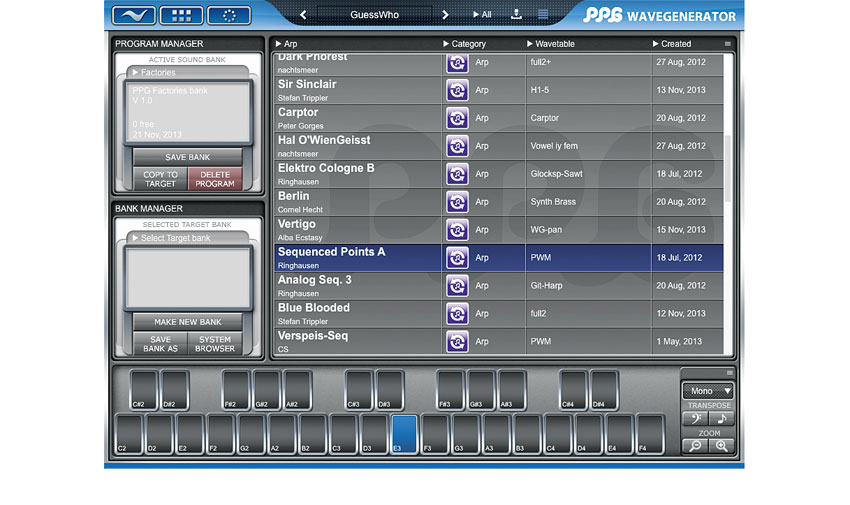MusicRadar Verdict
An exceptional iPad synth proves to be no less exceptional on Mac and PC - buy both if you can afford it.
Pros
- +
Sounds amazing. Wave drawing! Powerful Wave Grid wavetable. Plenty of modulation options. Extensive library, exchanges with iPad.
Cons
- -
Steep learning curve. Navigation a bit less fluid than on iPad.
MusicRadar's got your back

Wolfgang Palm PPG WaveGenerator

Graphical editors

Browser
As far as we're aware, PPG WaveGenerator is the first soft synth to start out on iOS, then get ported to Mac and PC (VST/AU). In fact, the whole project is really the latest phase in the life's work of synth design legend Wolfgang Palm, creator of the original PPG Wave hardware, so PPG WaveGenerator should be viewed as a continuation of that lineage.
"PPG WaveGenerator debuted last year as an iPad app and the desktop version is the same in almost every respect"
PPG WaveGenerator debuted last year as an iPad app (and has since been joined on that platform by PPG WaveMapper), and the desktop version is the same in almost every respect. So why are we reviewing it again?
Simply, that we felt it was important to reevaluate it, to address the question of how well a synth that seemed terrific on iPad would fare in a full-on desktop DAW context. Would it suddenly seem rather toylike after all? Can it stand up sonically to today's best soft synths? Let's find out...
WaveGenerator takes the original PPG Wave concept and adds to it the ability to modify and create your own waveforms. It comes with a library of factory waves stored in wavetables, many of which are sourced from the original Wave synths. These are loaded into the easy access Wave Grid on the right, which can house up to 256 waves in its 16x16 matrix. The wavetable is manipulated to generate evolving sounds, as the 'playback head' travels through it.
WaveGenerator features three oscillators, each of which has independent access to a specific wave in the Wave Grid via its Offset setting. The oscillator design comprises two sections - Pitch and Wave - which between them grant independent control over Pitch, Glide, Pitch Modulation (two sources) and Wave Modulation (two sources).
As well as the oscillators, you get three noise generators. One of these is audible, while the other two join the 13 (!) envelopes and four LFOs as modulation sources. Every assignment slot on each of the many modulation targets has access to its own particular selection of sources from that array, although three of the LFOs and six of the envelopes are dedicated to the oscillators. The key modulation source, however, is the Wave Envelope, which, along with the Wave Grid path (set in the Wave Grid), controls the trajectory of travel through the wavetable.
WaveGenerator's feature set is completed with a global low-pass Filter, a delay effect, an arpeggiator/gate (Arptor), a user-configurable keyboard and a dual amplifier. This last offers a great deal of flexibility in terms of routing individual oscillators and their mixed signals at the output stage. Finally, although you can't import raw audio files for resynthesis into waves, you can transform image files (JPEG, BMP, etc) by dragging them into the Image Transformer window.
Want all the hottest music and gear news, reviews, deals, features and more, direct to your inbox? Sign up here.
Off the Grid
Programming involves three main pages: Wave, Parameter and Aux, selected in the top left corner. Wave hosts the Wave and Spectrum Editors on the left and Wave Grid on the right, while Parameter combines the Oscillator and Envelope on the left with Noise, Filter, Dual Amplifier, Ring Mod and LFO parameters on the right. The Aux page is where you'll find the Image Transformer, Delay, Arptor and various global parameters such as keyboard behaviour.
WaveGenerator is an incredibly powerful and - once you understand what it does and how it does it - surprisingly approachable synth. Nonetheless, we were still glad to see over 700 presets in its locker, lovingly designed by a number of producers.
The 150 or so preset wavetables can also be accessed independently at the top of the Wave Grid, with your own creations saved to the wavetable user folder. Selective loading is implemented, too, enabling certain elements to be pulled directly from presets (just the oscillators, for example) or retained in the current patch when loading a new one - great for quick patch modification.
In addition to editing waveforms, there's a lot of flexibility within the Wave Grid for setting the Path through the wavetable, which can be auditioned by dragging the mouse pointer through the Grid. The Editor and Grid aspects are two of the synth's standout features.
Plugged up
"It's superb for bouncy basses, glassy, evolving pads, sparkling keyboard sounds and 'soundtrack'-style effects"
Other useful features include the oscillator solo mode, letting you work on the currently selected oscillator in isolation. The real-time green tracer that tracks the Wave Grid and envelope paths is also welcome, providing instant visual feedback as to what's actually happening with all those waves. Finally, should you get lost, the context-sensitive help resolves most queries, often doing away with the need to consult the manual.
The plugin version of WaveGenerator impresses us every bit as much as the iPad edition. It's superb for bouncy basses, glassy, evolving pads, sparkling keyboard sounds and 'soundtrack'-style effects. It also benefits from excellent real-time control possibilities via the X and Y parameters.
These interpret the position of the mouse pointer on each key of the on-screen keyboard - an adaptation of a feature that worked well on the iPad. In the VST version, not only do X and Y respond to pointer position, but they can also be mapped to MIDI CCs.
The crest of a Wave
Wave Generator is a stupendous synth - incredibly creative and sonically superlative. It does have its idiosyncrasies, certainly, not to mention a reasonably steep learning curve; but what you get back from it makes the effort more than worth it.
That said, the iPad version is functionally almost identical but with the added bonus of being much more tactile and considerably cheaper. With patches fully interchangeable between the two, though, the ideal solution would be to own both.
Computer Music magazine is the world’s best selling publication dedicated solely to making great music with your Mac or PC computer. Each issue it brings its lucky readers the best in cutting-edge tutorials, need-to-know, expert software reviews and even all the tools you actually need to make great music today, courtesy of our legendary CM Plugin Suite.
